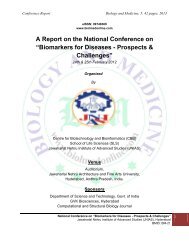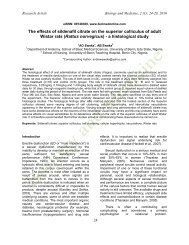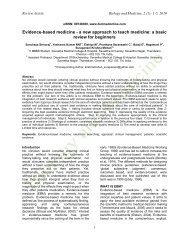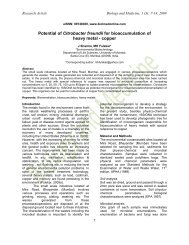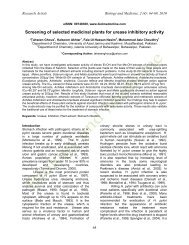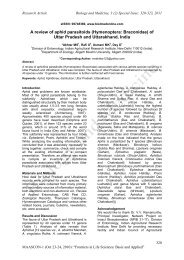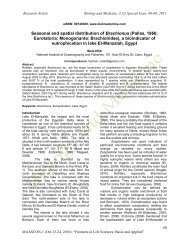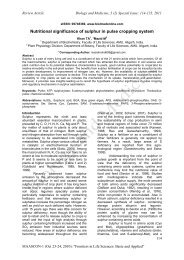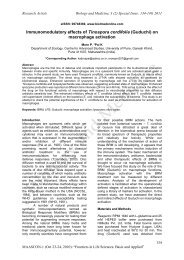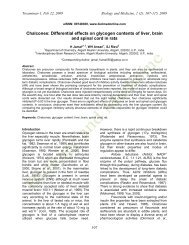Changes in lipid profile of rat plasma after chronic administration of ...
Changes in lipid profile of rat plasma after chronic administration of ...
Changes in lipid profile of rat plasma after chronic administration of ...
- No tags were found...
Create successful ePaper yourself
Turn your PDF publications into a flip-book with our unique Google optimized e-Paper software.
Research Article Biology and Medic<strong>in</strong>e, 2 (3): 58-63, 2010Statistical AnalysisThe group data was expressed as Mean ±SEM (Standard Error <strong>of</strong> the Mean). Unpaired"t" tests were done for statistical significancetests. SPSS (Statistical Package for SocialScience) for WINDOWS (Ver. 11) was appliedfor the analysis <strong>of</strong> data. Differences betweengroups were considered significant at p < 0.05,0.01 and 0.001.ResultsSimilar trend <strong>of</strong> changes <strong>in</strong> the <strong>lipid</strong> <strong>pr<strong>of</strong>ile</strong>parameters were observed <strong>in</strong> both male andfemale <strong>rat</strong>s dur<strong>in</strong>g the course <strong>of</strong> research. Thedecrement <strong>of</strong> <strong>plasma</strong> triglycerides <strong>in</strong> bothsexes <strong>of</strong> animals was noteworthy and it wasstatistically very highly significant (p=0.001***).In case <strong>of</strong> total cholesterol, a decreas<strong>in</strong>g trendwas observed <strong>in</strong> both male (p=0.296) andfemale <strong>rat</strong>s (p=0.511). On the contrary theconcent<strong>rat</strong>ion <strong>of</strong> VLDL, LDL and HDLcholesterol was <strong>in</strong>creased <strong>in</strong> both male andfemale <strong>rat</strong>s and the <strong>in</strong>crease <strong>of</strong> LDL <strong>in</strong> male<strong>rat</strong>s was statistically significant (p=0.047*).The <strong>in</strong>crease <strong>in</strong> VLDL and HDL <strong>in</strong> both maleand female <strong>rat</strong>s was not statistically significant(Table 2, Graph 1 and 2).DiscussionAtherogenicity with subsequent cardiovascularmanifestations is one <strong>of</strong> the major causes <strong>of</strong>death and morbidity <strong>in</strong> the world (Raju andB<strong>in</strong>da, 2005). Various studies <strong>in</strong>dicate thathigh serum cholesterol levels are stronglyrelated to coronary atherosclerosis and<strong>in</strong>creased risk <strong>of</strong> cardiovascular diseases.Cl<strong>in</strong>ical studies have also shown that lower<strong>in</strong>glevels <strong>of</strong> serum cholesterol us<strong>in</strong>g diet or drugsdecreases the <strong>in</strong>cidence <strong>of</strong> coronary heartdisease (Ste<strong>in</strong>er and Li, 2000; Treasure et al.,1995). The levels <strong>of</strong> serum TC and TG werefound to be significantly reduced <strong>in</strong> the LNRtreated animals. This might be due to thereduced hepatic triglyceride synthesis and orreduced lipolysis that might be due to the<strong>in</strong>crease <strong>in</strong> serum <strong>in</strong>sul<strong>in</strong> levels <strong>in</strong> the LNRtreated <strong>rat</strong>s. (Sivaraj et al., 2009). Theobserved hypotriglyceridemic effect may bedue to a decrease <strong>of</strong> fatty acids synthesis(Bopanna et al., 1997), enhanced catabolism<strong>of</strong> LDL, activation <strong>of</strong> LCAT and tissues lipases(Khanna et al., 2002) and/or <strong>in</strong>hibition <strong>of</strong>acetyl-CoA carboxylase (McCarty, 2001) andproduction <strong>of</strong> triglycerides precursors suchacetyl-CoA and glycerol phosphate.The underly<strong>in</strong>g mechanism by whichLNR exerts its cholesterol lower<strong>in</strong>g effectseems to be a decrease <strong>in</strong> cholesterolabsorption from the <strong>in</strong>test<strong>in</strong>e, by b<strong>in</strong>d<strong>in</strong>g withbile acids with<strong>in</strong> the <strong>in</strong>test<strong>in</strong>e and <strong>in</strong>creas<strong>in</strong>gbile acids excretion (Kritchevsky, 1978; Kellyand Tsai, 1978). LNR can also act bydecreas<strong>in</strong>g the cholesterol biosynthesisespecially by decreas<strong>in</strong>g the 3-hydroxy-3-methyl-glutaryl coenzyme A reductase(HMGCoA reductase) activity, a key enzyme<strong>of</strong> cholesterol biosynthesis (Kedar andChakrabarti, 1982; Sharma et al., 2003) and/orby reduc<strong>in</strong>g the NADPH required for fattyacids and cholesterol synthesis (Chi, 1982).HDL cholesterol is an <strong>in</strong>dependent negativerisk factor for coronary artery disease, atpresent represent<strong>in</strong>g the only protective factoraga<strong>in</strong>st atherosclerosis. The HDL <strong>in</strong>creas<strong>in</strong>geffect <strong>of</strong> LNR is largely attributed to its centralfunction <strong>in</strong> the reverse cholesterol transport, aprocess whereby excess cell cholesterol istaken up and processed by HDL particles forfurther delivery to the liver for metabolism(Mart<strong>in</strong>ez et al., 2004).ConclusionLNR is a popular Ayurvedic formulation used<strong>in</strong> the treatment <strong>of</strong> pandu (anemia) <strong>in</strong>Bangladesh. In the present study, the changescaused by LNR was not congruent <strong>in</strong>case <strong>of</strong>all the studied parameters <strong>of</strong> <strong>lipid</strong> <strong>pr<strong>of</strong>ile</strong>particularly <strong>in</strong>case <strong>of</strong> LDL and VLDL. So itnecessitates further <strong>in</strong>vestigation for us<strong>in</strong>gLNR <strong>in</strong> the patients who are at risk <strong>in</strong> thedevelopment <strong>of</strong> cardiovascular disease.ReferencesAsolkar AV, Kakkar KK, Chakre OJ, 1992. Glossary<strong>of</strong> Indian Medic<strong>in</strong>al plants with active pr<strong>in</strong>ciples.Publication and <strong>in</strong>formation directo<strong>rat</strong>e (CSIR), NewDelhi, 1: 287.Bhattacharya SK, Satyan KS, Chakrobarti A, 1997.Effects <strong>of</strong> Tras<strong>in</strong>a: An Ayurvedic herbal formulationon pancreatic islet superoxide dismutase activity <strong>in</strong>hyperglycemic <strong>rat</strong>s. Indian Journal <strong>of</strong> ExperimentalBiology, 35(3): 297-299.Bopanna KN, Kannan J, Gadgil S, Balaraman ER,Rathore SP, 1997. Antidiabetic andantihyperglycaemic effects <strong>of</strong> neem seed kernelpowder on alloxan diabetic rabbits. Indian Journal <strong>of</strong>Pharmacology, 29: 162–167.Chi MS, 1982. Effects <strong>of</strong> garlic products on <strong>lipid</strong>smetabolism <strong>in</strong> cholesterol fed <strong>rat</strong>s. In: Proceed<strong>in</strong>gs<strong>of</strong> Society <strong>of</strong> Experimental Biology and Medic<strong>in</strong>e,171: 174–178.Davis SN, Granner DK, 1996. Insul<strong>in</strong>, OralHypoglycemic Agents, and the pharmacology <strong>of</strong> theEndocr<strong>in</strong>e Pancreas, 9th ed., Chap. 60, ed. ByHardman J.G., Limbird L.E., Mol<strong>in</strong><strong>of</strong>f P.B., RuddonR.W., Gilman A.G., McGraw Hill, New York, pp.1487-1518.60




